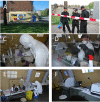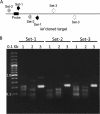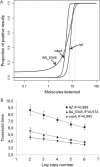Sensitive and Specific Recombinase Polymerase Amplification Assays for Fast Screening, Detection, and Identification of Bacillus anthracis in a Field Setting
- PMID: 29602786
- PMCID: PMC5960963
- DOI: 10.1128/AEM.00506-18
Sensitive and Specific Recombinase Polymerase Amplification Assays for Fast Screening, Detection, and Identification of Bacillus anthracis in a Field Setting
Abstract
Four isothermal recombinase polymerase amplification (RPA) assays were developed for fast in-field identification of Bacillus anthracis The RPA assays targeted three specific sequences (i.e., the BA_5345 chromosomal marker, the lethal factor lef [from pXO1], and the capsule-biosynthesis-related capA [from pXO2]) and a conserved sequence in the adenylate cyclase gene (adk) for the Bacillus cereus group. B. anthracis-specific RPA assays were tested first with purified genomic DNAs (n = 60), including 11 representatives of B. anthracis, and then with soil (n = 8) and white powder (n = 8) samples spiked with inactivated B. anthracis spores and/or other biological agents. The RPA assays were also tested in another laboratory facility, which blindly provided DNA and lysate samples (n = 30, including 20 B. anthracis strains). RPA assays displayed 100% specificity and sensitivity. The hands-off turnaround times at 42°C ranged from 5 to 6 min for 102 genomic copies. The analytical sensitivity of each RPA assay was ∼10 molecules per reaction. In addition, the BA_5345 and adk RPA assays were assessed under field conditions with a series of surface swabs (n = 13, including 11 swabs contaminated with B. thuringiensis spores) that were blindly brought to the field laboratory by a chemical, biological, radiological, and nuclear (CBRN) sampling team. None of the 13 samples, except the control, tested positive for B. anthracis, and all samples that had been harvested from spore-contaminated surfaces tested positive with the adk RPA assay. All three B. anthracis-specific RPA assays proved suitable for rapid and reliable identification of B. anthracis and therefore could easily be used by first responders under field conditions to quickly discriminate between a deliberate release of B. anthracis spores and a hoax attack involving white powder.IMPORTANCE In recent decades, particularly following the 11 September 2001 and Amerithrax attacks, the world has experienced attempts to sow panic and chaos in society through thousands of white-powder copycats using household powders to mimic real bioterrorism attacks. In such circumstances, field-deployable detection methods are particularly needed to screen samples collected from the scene. The aim is to test the samples directly using a fast and reliable assay for detection of the presence of B. anthracis While this would not preclude further confirmatory tests from being performed in reference laboratories, it would bring useful, timely, and relevant information to local crisis managers and help them make appropriate decisions without having to wait for quantitative PCR results (with turnaround times of a few hours) or phenotypic identification and sequencing (with turnaround times of a few days). In the current investigation, we developed a set of isothermal RPA assays for the rapid screening and identification of B. anthracis in powders and soil samples, with the purpose of discriminating a deliberate release of B. anthracis spores from a hoax attack involving white powder; this would also apply to dispersion by spraying of aerosolized forms of B. anthracis Further work is now ongoing to confirm the first observations and validate the on-site use of these assays by first responders.
Keywords: biothreat agents; isothermal amplification; quantitative PCR.
Copyright © 2018 Bentahir et al.
Figures




Similar articles
-
Development and validation of a real-time quantitative PCR assay for rapid identification of Bacillus anthracis in environmental samples.Appl Microbiol Biotechnol. 2010 Nov;88(5):1179-92. doi: 10.1007/s00253-010-2848-0. Epub 2010 Sep 9. Appl Microbiol Biotechnol. 2010. PMID: 20827474
-
Rapid identification of Bacillus anthracis spores in suspicious powder samples by using matrix-assisted laser desorption ionization-time of flight mass spectrometry (MALDI-TOF MS).Appl Environ Microbiol. 2013 Sep;79(17):5372-83. doi: 10.1128/AEM.01724-13. Epub 2013 Jun 28. Appl Environ Microbiol. 2013. PMID: 23811517 Free PMC article.
-
Rapid genotypic detection of Bacillus anthracis and the Bacillus cereus group by multiplex real-time PCR melting curve analysis.FEMS Immunol Med Microbiol. 2005 Feb 1;43(2):301-10. doi: 10.1016/j.femsim.2004.10.005. FEMS Immunol Med Microbiol. 2005. PMID: 15681162
-
Recent advances in recombinase polymerase amplification: Principle, advantages, disadvantages and applications.Front Cell Infect Microbiol. 2022 Nov 28;12:1019071. doi: 10.3389/fcimb.2022.1019071. eCollection 2022. Front Cell Infect Microbiol. 2022. PMID: 36519130 Free PMC article. Review.
-
Recombinase polymerase amplification in the molecular diagnosis of microbiological targets and its applications.Can J Microbiol. 2022 Jun;68(6):383-402. doi: 10.1139/cjm-2021-0329. Epub 2022 Apr 8. Can J Microbiol. 2022. PMID: 35394399 Review.
Cited by
-
Detection and Identification of Bacillus anthracis: From Conventional to Molecular Microbiology Methods.Microorganisms. 2020 Jan 16;8(1):125. doi: 10.3390/microorganisms8010125. Microorganisms. 2020. PMID: 31963339 Free PMC article. Review.
-
Telecommunication Facilities, Key Support for Data Management and Data Sharing by a Biological Mobile Laboratory Deployed to Counter Emerging Biological Threats and Improve Public Health Crisis Preparedness.Int J Environ Res Public Health. 2021 Aug 26;18(17):9014. doi: 10.3390/ijerph18179014. Int J Environ Res Public Health. 2021. PMID: 34501606 Free PMC article.
-
Calibration of an Upconverting Phosphor-Based Quantitative Immunochromatographic Assay for Detecting Yersinia pestis, Brucella spp., and Bacillus anthracis Spores.Front Cell Infect Microbiol. 2020 Apr 24;10:147. doi: 10.3389/fcimb.2020.00147. eCollection 2020. Front Cell Infect Microbiol. 2020. PMID: 32391285 Free PMC article.
-
Biosensors and Bioassays for the Medical Detection of Bacillus Anthracis and Diagnosis of Anthrax.Curr Med Chem. 2025;32(16):3123-3133. doi: 10.2174/0109298673310620240704132204. Curr Med Chem. 2025. PMID: 39005126 Review.
-
Confronting the threat of bioterrorism: realities, challenges, and defensive strategies.Lancet Infect Dis. 2019 Jan;19(1):e2-e13. doi: 10.1016/S1473-3099(18)30298-6. Epub 2018 Oct 16. Lancet Infect Dis. 2019. PMID: 30340981 Free PMC article. Review.
References
-
- Okinaka RT, Cloud K, Hampton O, Hoffmaster AR, Hill KK, Keim P, Koehler TM, Lamke G, Kumano S, Mahillon J, Manter D, Martinez Y, Ricke D, Svensson R, Jackson PJ. 1999. Sequence and organization of pXO1, the large Bacillus anthracis plasmid harboring the anthrax toxin genes. J Bacteriol 181:6509–6515. - PMC - PubMed
Publication types
MeSH terms
Substances
LinkOut - more resources
Full Text Sources
Other Literature Sources
Molecular Biology Databases
Miscellaneous

